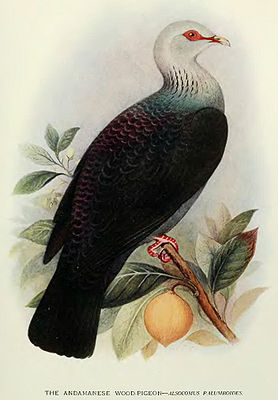Andaman pigeon
| Andaman pigeon | ||||||||||
|---|---|---|---|---|---|---|---|---|---|---|

Andaman pigeon ( Columba palumboides ) |
||||||||||
| Systematics | ||||||||||
|
||||||||||
| Scientific name | ||||||||||
| Columba palumboides | ||||||||||
| ( Hume , 1873) |
The Andaman pigeon ( Columba palumboides ), also known as the Andaman forest pigeon , is a monotypical species of pigeon birds. It occurs exclusively on the Andaman and Nicobar Islands. The population of the species is unknown. However, the IUCN classifies the species as near threatened , as it is an endemic island species on which the increasing deforestation of the primary forests has a negative impact.
In German usage a distinction is made between the Andaman pigeon and the Andaman green pigeon and the Andaman cuckoo pigeon . Both species belong to other genera of the pigeon birds.
Appearance
The Andaman pigeon reaches a body length of up to 42 centimeters. The body size of the females varies between 36.2 and 42.5 centimeters. The males reach body lengths of 38 to 40 centimeters. In terms of body size, it is thus similar to a domestic pigeon of a larger breed. However, it is built more compact overall. Your forehead is flatter. The gender dimorphism is only very slightly pronounced. The females are a little darker than the males. Their neck plumage is less silver.
The head and neck of the Andaman pigeon is silver gray. The coat and back are dark with iridescent green and purple feather hems. The chest is light gray. The under tail-coverts are dark gray. The beak is reddish at the base. Towards the tip, the bill brightens yellowish. The iris is yellow inside and red outside. The dark circles are purple. The feet are bright red.
Distribution area and habitat
The Andaman and Nicobar Islands are an Indian Union Territory , 1,255 km southeast of Kolkata and 1,190 km east of Chennai . They extend from 6 ° 45 'to 13 ° 41' north, roughly along the 93rd east longitude west of the coast of Thailand and northwest of Sumatra . The 10th parallel with the Ten Degree Channel separates the northern Andaman Islands from the Nicobar Islands .
The Andaman pigeon is found on all islands in the Nicobar archipelago. It is a very mobile pigeon species that can be found on any of the still forested islands. The habitat of the Andaman pigeon are dense evergreen forests. Such forests still occur on both the Nicobar Islands and the Andaman Islands. However, increasing deforestation will have a negative impact on the species population.
behavior
The Andaman pigeon has so far been observed in pairs and in small flocks. It only lives in forests and is a very shy species. It only lives in trees. In its behavior and also in its body shape, it is reminiscent of a large fruit pigeon . She only eats fruits and berries. Walnut-sized fruits have been found in the crop of dissected Andaman pigeons. It does not seem to pick up fruit that has fallen on the ground. Like many fruit-eating, forest-dwelling pigeons, it shows a nomadic behavior. Nothing is known about the breeding biology of this species.
supporting documents
Individual evidence
- ↑ BirdLife Factsheet , accessed July 1, 2009
- ↑ Gibbs, p. 205
- ↑ Rösler, p. 205
- ↑ Rösler, p. 94
literature
- David Gibbs, Eustace Barnes and John Cox: Pigeons and Doves - A Guide to the Pigeons and Doves of the World . Pica Press, Sussex 2001, ISBN 90-74345-26-3 .
- Alois Münst and Josef Wolters: Tauben - The species of wild pigeons , 2nd expanded and revised edition, Verlag Karin Wolters, Bottrop 1999, ISBN 3-9801504-9-6 .
- Gerhard Rösler: The wild pigeons of the earth - free living, keeping and breeding . Verlag M. & H. Schaper, Alfeld Hannover 1996, ISBN 3-7944-0184-0 .
Web links
- Columba palumboides inthe IUCN 2013 Red List of Endangered Species . Listed by: BirdLife International, 2012. Retrieved October 5, 2013.
